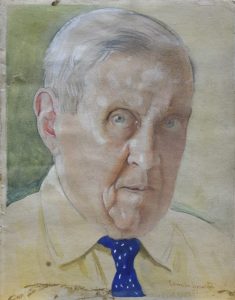Biography

INNOCENTI Camillo, painter (Rome 1871 – 1961). His father Augusto, a wealthy architect, directed him to classical studies, but his innate passion for painting led him, between 1887 and 1889, to make an apprenticeship with Ludovico Seitz, epigone of the Nazarenes, friend of his mother, who was decorating the gallery of candelabra in the Vatican.
With great intellectual honesty, the German painter understands that the young Camillo is brought to the landscape and not to the celebratory fresco and advises him to change his teacher. Thus, between 1889 and 1892, with great desperation of his father who considered him a madman, the young man’s great infatuation for Antonio Mancini, who had recently arrived in Rome and still unknown, had opened a studio in via Flaminia 114. The system Spotted in color, with spatulated and shimmering layers by Mancini, he exerts a lively suggestion on Camillo and by his own admission inspires him many paintings of that period. He also received the encouragement from Morelli, who more than once went to visit Naples, doing several studies of the Tiber for him, which the master would use for his painting The fishermen of the Jordan.
In 1893 he exhibited the first painting (Carnival Mask) to the Amateurs and Cultures of Rome: In 1894 he went for the first time to Venice where he made friends with the well-known painter Ettore Tito, a guest of whom he returned to paint in the lagoon in the summers of the ’95 and ’98, replacing the palette from the dark registers of Mancini’s derivation with a more fluid and atmospheric brushstroke with bright colors.
In 1898 he won the competition for the national pensioner at the Academy of Fine Arts in Rome, going to specialize in Spain, where he deepened the painting of Velasquez and Goya. Travels to Europe touching Germany, France, Holland and England: He returned to Italy in 1903 and made his first Divisionist experiences with the Roman group (Balla, Noci, Linone). The following year he joined the XXV Group of the Roman countryside with the nickname “Pekingese dog” in homage to the flirtatiousness and frivolity of his female characters.
He paints a series of works on the theme of the Roman Agro (Ciociara song), with a brush stroke full of atmospheric values that referred to his friend Tito. But it is only after 1905 that adherence to the Divisionist chromatism with violent “fauve” ignitions becomes complete (The visit, After the bath).
With the Venice Biennale of 1909 (personal room with twenty works exhibited by his friend Ugo Ometti) he obtained the first great international success.
He became the spokesman for the Roman divisionist intimist, characterized by the brushwork with wide strands, all focused on the female figure caught in provocative intimacy in the closed spaces of refined bourgeois rooms with a boldinian flavor.
It is no coincidence that Paris will give the painter the official consecration, in April 1913, with a personal exhibition of 30 oils at the prestigious Bernheim-Jeune Gallery, preceding the personal exhibitions of French artists of the caliber of Matisse, Vuillard, Bonnard, Signac and to finish Cezanne.
His fame remained very high until 1925, when he moved to Egypt to take up the position of director of the institution of the Academy of Fine Arts in Cairo.
Hurriedly repatriated to Italy in 1942, due to the war events, he finds himself completely forgotten, far from the artistic environment that, after the war, had taken other routes.
He died in Rome, ninety years old and very poor, in a ward of San Camillo Hospital on January 4, 1961.